

TLW's Vikingscope (Viking Historyscope) |
By T.L. Winslow (TLW), the Historyscoper™ |
© Copyright by T.L. Winslow. All Rights Reserved. |
Original Pub. Date: Feb. 10, 2020. Last Update: Mar. 15, 2020. |
Westerners are not only known as history ignoramuses, but double dumbass history ignoramuses when it comes to Vikings and Viking history. Since I'm the one-and-only Historyscoper (tm), let me quickly bring you up to speed before you dive into my Master Historyscope.
The Viking Age lasted from 793-1066 C.E., during which they used their longships to terrorize and colonize Europe from France to Russia, the Mediterranean, North Africa, the Middle East, Iceland, Greenland, and North Am. (Vinland).
In 740 in response to forcing them to convert to Islam, and the evacuation of their territory by the Muslims to quell rebellions in Syria et al., the Khazars (Hazaras Turks) convert to Judaism (at least their leaders, the rest following by 840), and withdraw beyond the Caucasus, going on to expand from the Caspian Sea to the Dnieper River, and as far S as the Black Sea, causing the Slavic tribes to turn to the Scandinavian Varangians (Vikings) (Rus) (proto-Russians) to the N for trade; because of them many modern Jews have hooked noses and speak Yiddish?; the Jewish conversion of the Khazars is a myth?

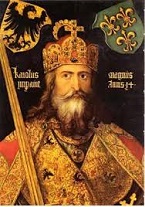

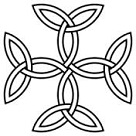
In 751 Charles Martel's son Pepin III the Short (714-68), mayor of the palace of Paris gets Pope Zachary to agree to let him dethrone the whimpy Merovingian king (since 743) Childeric III, and he is elected the new king of the short, er, Franks (first Carolingian king) at a gathering of Frankish nobles in the Merovingian capital of Soissons, and anointed and crowned at the Abbey of St. Medard, officially deposing Childeric, who is packed off to to the Monastery of Saint-Bertin next year with his son Theuderic (Saint-Omer and Saint-Wandrille?); for the first time bishops attend with a rank equal to secular nobles; annointing with oil superseded the right of blood descent?; he founded his own Carolingian (Carlovingian) Dynasty (House of Pepin) (ends 987), with the remnants of the Merovingians going underground and plotting a comeback (until ?); it has its own Carolingian Cross. Pepin III the Short's giant 7-foot son Charlemagne (742-814) spends his life not only fighting the pesky Muslims in Spain but crushing the remaining pagans in Saxony, Frisia (Netherlands) and Norseland, adopting the Muslim tactic of forced conversion, and building an empire in western and central Europe, for which Pope Leo III crowns him the first Holy Roman Emperor (HRE) on Christmas Day of 800. Too bad, his Sword and Cross technique backfires when the riled-up Norse take to their long ships and become pagan pirate Vikings, terrorizing the Christian coasts at will, and go on to make it their lifestyle for centuries, which cause France and the rest of Europe to go into a defensive under-siege mode called feudalism, see any Road Warrior movie, how many arrests in twenty years, zero point six? Honorable mention should be given to Charlemagne's nephew Roland (-778), who became the subject of endless hero stories.

In 781 Charlemagne's son Louis (Ludwig) I (the Pious) (the Fair) (the Debonaire) (778-840) becomes king of Aquitaine, followed in 813 by HRE, and in 814 by king of the Franks. Too bad, under the weight of Viking raids the Holy Roman Empire becomes kaput by 924, and when it is finally revived in 962 it was German king Otto I the Great who does it, showing how the wheel has turned in 500 years.
In 793 the Antichrist Thor's Hammer Odin's Raven Norse Vikings sack the English island Lindisfarne Monastery in Northumberland (founded 635), terrorizing and messing it up so much that it haunts the English for cents.?; many mss. are destroyed, incl. history materials about the Celts, plaguing later historians - causing Viking victims to see Devil horns on their helmets in their nightmares?
In 795 the first Viking raids on Ireland begin in Reachrainn (Lambay Island 5 mi. NE of the Irish mainland off N County Dublin), Rathlin Island (northernmost point of Northern Ireland), plus two monasteries on the W coast incl. Iona and Inishmurray; at this time there are no cities, stone bridges, or foreign trade to speak of in Ireland; about this time the Gaelic poem The Guardian Storm is written; "It plows up the wild hair of the sea,/ I have no fear that Viking hosts/ Will come over the water to me". :)
In 798 the Vikings destroy the monastery on St. Patrick's Island in County Dublin.
In 799 the Island of (Ile de) Noirmoutier off the WC coast of France is raided by Vikings, who attack the monastery of St. Philibert of Jumieges (Jumièges) (608-84), causing the monks to abandon their home in 836, settling in 875 in Tournus in EC France on the right bank of the Saone River.
In the 9th cent. C.E. Viking traders begin bringing slaves into Ireland, lasting until the 1000s.
In the 9th cent. C.E. Vikings found the town of Arklow ("meadow of Arnkell") in County Wicklow at the mouth of the Avoca (Avonmore) River under Arklow Hill on the E coast of Ireland near Dublin (modern-day pop. 14K/13k); the Nineteen Arches Bridge linking the S and N parts (Ferrybank) of town becomes the longest handmade stone bridge in Ireland.
About 800 Vikings found the town of Wexford ("Veisafjordr" = inlet of the mud flats) on the S side of Wexford Harbor, estuary of the Slaney River near the SE corner of Ireland (modern-day pop. 20K).
In 802 the Vikings sack and burn the Monastery of Iona on the Isle of Mull on the W coast, and begin dominating Scotland.
In 812 the Vikings found the city of Limerick (Luimneach) (Loch Luimnigh) (modern-day pop. 94K/162K) in midwest Ireland (Munster) as a walled city on King's Island in the Shannon River.
In the 830s Viking raids in Ireland grow more intense.
In 834 the pagan Danish Vikings are successful in Ireland, overrunning the N and taking Dorestad (934-7), along with Dublin (Gael. "Diblinn" = black pool) (a dark tidal pool where the Poddle River enters the Liffey River at the site of the Castle Gardens at the rear of Dublin Castle?) (Gael. Baile Atha Cliath, "town of the ford of the hurdles", from the wattled frames spanning the Liffey River) in EC Ireland (Leinster) at the mouth of the Liffey River on Dublin Bay (inlet of the Irish Sea) (modern-day pop. 550K/1.9M), and ruling a unified Ireland until 841; originally the Viking settlement of Dyflin near the Christian Gaelic settlement of Ath Cliah ("ford of hurdles"), where all the main highways of Ireland meet; 40-ft.-high. 80-ft.-diam Thingmote Hill is used as an assembly location (destroyed 1685); no main place names in Ireland (except Waterford) end up getting named by the Norse, unlike in Scotland, although Ulster, Munster, and Leinster are indicative of an earlier Norse-Gaelic pidgin?; the Vikings begin their attacks on England and the continent, approaching the mouth of the Thames River just as King Egbert of Wessex thinks he has England sewn up for Christ, starting small with hit-and-run raids, alternating with raids on the continent, then working up to a serious invasion in 865.
In 836 the first known inland Viking raid in Ireland takes place.
In 840 the Vikins begin setting up forts, ramping up their attacks to the point of conquering Ireland, causing Irish kings and abbots to mount defenses and counterattacks and hold their ground; Dublin becomes the center of Viking trade with the Continent after Turgesius (Turgeis) (Thorgest) (-845) arrives and declares himself "king of all the foreigners in Erin", and a longship port is constructed at a ford on the Liffey River; Dublin becomes the seat of Viking power in Ireland; meanwhile the continual wars between petty Irish kings draw Vikings into on-again off-again alliances, the Vikings eventually becoming allies of the kings of Leinster.
In 841 the Vikings begin to permanently settle Dublin and Limerick, wintering over until 842.
In early 842 the Vikings complete their first "over-winter" in Dublin; the Irish and Vikings form an alliance for the first time; after the thaw, the Vikings sack London and Rochester (former Roman town of Durobrivae) in Kent.
In Aug. 843 HRE Lothair I's brothers Louis II the German and Charles II the Bald force a very done deal family compact on him, the Treaty of Verdun (40 mi. W of Metz, where the Meuse River divides into five branches), which causes him to accept the division of the Carolingian Empire (and all hopes of a resurrected supersized Roman Empire), and lays the foundation for the modern regular-size states of France, Germany, and the Netherlands, creating three Carolingian dynasties that rule Italy (until 875), Germany (until 911), and France (until 987); Lothair keeps the empty title of HRE, remains king of Italy (excluding Benevento) and an amorphous "middle kingdom" of Lorraine (Lotharingia) (Lothringen) bounded by the Scheldt, Upper Meuse, Saone, and Rhone Rivers on the W, and the Rhine River and Frisia on the E, with Aix-la-Chapelle given to him as his capital; Alsace and Friesland are incl. until 870; Louis II the German remains king of the German-speaking East Franks, and receives Saxony, Franconia, and all territory (except Frisia) E from the Rhine; Charles II the Bald remains king of the West Franks, and receives Carolingia, a Romance-speaking territory made up of West Francia and Aquitaine, Gascony, Septimania, etc., approximating medieval France (bounded by the Meuse, Saone and Rhone Rivers, plus the Spanish March as far as the Ebro River); meanwhile Frisia (the Low Countries) comes under Viking control, and the Vikings enter the Mediterranean.
In 843 Danish Vikings under chieftain Hastein (Hasteinn) (Haesten) Hasting) (Ansting) (son of Ragnar Lodbrok?) occupy Noirmoutier Island off the W coast of France - I'll be baack?
In winter 850/1 Danish Viking raiders overwinter in England (on the Isle of Thanet in Kent) for the first time ever, beginning a transition to colonizing; meanwhile the Norwegian and Danish contingents of Vikings begin warring between themselves for power in Ireland, causing a 40-year lull in Viking raiding activity there?
In 853 the Vikings found Waterford (Norse "wether" + "fjord" = ram + fjord) in Munster, SE Ireland at the outlet of the Suir (Siur) River (modern-day pop. 53K/83K); in 902 it is vacated along with all other longship ports after the native Irish drive them out; in 914 the Vikings return and build it into Ireland's first city, becoming the oldest city in Ireland to survive to modern times.
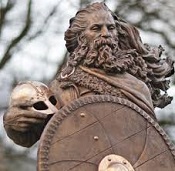
In 860 Halfdan the Black dies by accidental drowning while his mother's brother Guthorm holds his enemies at bay, and his son Harald I Fairhair (850-933) becomes king of several small scattered Norse kingdoms based in SE Norway, beginning a campaign in 866 to unite it while taking a vow not to cut or comb his fair hair until he is done, gaining the nickname Shockhead/Tanglehair (until 872).
In 860 Vikings Hastein and Bjorn sack Narbonne, Nimes and Arles, then ravage as far N as Valence before moving to Italy and sacking Pisa and Lucca; at Luna Hastein plays sick and pretends to wish to convert to Christianity, getting the guards to take him to the church, where he jumps out of his stretcher and leads his card-carrying pagans in attacking the town (made-up but should be true?); after raiding Byzantine sites in the E Mediterranean they turn back, stopping in N Africa to buy some "blue men" (African slaves), which they later sell in Ireland; a Moorish fleet defeats them at the Straits of Gibraltar, but they manage to ravage Pamplona and return to the Loire River with 20 longships.
In 860 the first recorded appearance of the Viking Rus (Russians) (Varangians) at Constantinople - getting their piece of the Viking pie?
In 861 Duke Salomon of Brittany hires some Vikings to fight his enemy Robert IV the Strong, who hires his own Vikings; meanwhile other Vikings loot Paris, Toulouse, Cologne, Aix-la-Chapelle, and Worms, and build a settlement on an island in the Seine, but are driven away by the Vikings hired by the French lords, after which Robert is reconciled with Charles II the Bald, who creates the two Marches of Neustria in W France; the Breton March, called the Duchy of Maine, with capital at Le Mans is led by Robert IV the Strong (d. 866), with a mission to stop the advance of the Celtic Bretons between the Seine and Loire Rivers; the Norman March is created to stop the Norse, run by wardens (margraves); meanwhile Salomon lends Robert's enemy Louis II the Stammerer some troops.
In 861 the Vikings discover Iceland when a storm drives a ship to it.
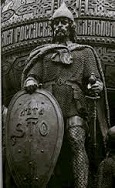
Russia's next top model is? In 862 Novgorod ("new town") (modern-day pop. 218K) (in modern times one of Russia's oldest towns) is founded on the Volkhov River by the Rus (from Finnish "ruoysi", meaning "those who rowed") Viking Ulrich; Scandinavian Varangian Viking prince Rurik (Riurik) (ON "famous ruler") (830-79) is allegedly invited by the people of Novgorod to rule their city, founding the Russian Tsar (named after Caesar) Dynasty, and reopening the Norse trade to the E that had been cut off by the Huns and Avars in the 5th and 6th cents., beginning trade with Constantinople and the Khazars along the Russian waterways of the Dvina, Dnieper, and Don Rivers; "Our country is large and has an abundance of everything, but there is no order or justice amongst us. Come and take possession of the land and govern us." (Ancient Chronicle of Kiev); Vikings Askold and Dir leave Rurik's Novgorod and sail S down the Dnieper River, founding the town of Kiev (modern-day pop. 2.9M/3.4M) and becoming its rulers; the E Slav town of Polotsk (modern-day pop. 82K) on the Polota and Dvina Rivers is first mentioned, becoming the most heavily fortified city in Kievan Rus.
In 870 an army of Danish Vikings under Ivar the Boneless invade England and capture East Anglian king (the last) Edmund, then ritually sacrifice him with the good ole blood-eagle, and destroy Peterborough Monastery; Ivar heads to Ireland, where he conquers Dublin, leaving his brother Halfdan in charge; at the end of the year the Viking hordes turn their attention to Wessex, which is all that stands between them and complete subjugation of the island, coming from East Anglia and invading the Kingdom of Wessex, disembarking from their longboats by the ferry crossing at Maidenhead ("Maiden Hythe" = new wharf) on the Thames River in modern-day Berkshire, then fight their way to Reading in modern-day Berkshire at the confluence of the Thames and Kennet Rivers 37 mi. W of London and 24 mi. S of Oxford, making it their regional power base - like we couldn't guess, just then a "he-ruh" arises to help the Anglo-Saxons fight for their "free-ee-ee-dom" and save Christian England from the Antichrist Vikings?
In 876 Forty Years Rest begin in Ireland (until 916), seeing Viking raids die down.
In 877 Mercia and Northumbria now have certified Viking Danish kings; Halfdan follows in the footsteps of his brother Ivar and sails to Ireland to secure the throne of Dublin, but is defeated and killed by Norwegian Vikings in the Battle of Strangford Lough; Guthrum is promoted to CIC of the Danish army based in Cambridge.
In 882 Varangian prince Oleg of Novgorod becomes supreme ruler of the Rus; the monks of Kiev begin the Ancient Kievan Chronicle, covering from 850-1110, telling how the Slavs have great respect for the Vikings and their dragon-prowed longships and cool Viking weapons.
In 903 the Vikings invade Alba (Scotland), ransacking Dunkled, then overwintering in Fortriu (until 904).
In 904 the Vikings continue ransacking Scotland, virtually annihilating Strathearn, then heading S for York.
In 907 Varangian Rus leader Oleg of Kiev extorts a 1-sided trade agreement with the Byzantines, followed by a 2nd more lavish one in 911, making the Byzantines give them free supplies and baths coming and going, with the Byzantines requiring them to enter Constantinople in groups of 50 unarmed, live in the St. Mamas quarter, and be on commercial business bringing merchandise and refrain from violence.
In 909 the combined forces of Wessex and Mercia launch a 5-week exploratory attack against the Northumbrian Danes at Lindsey, successfully capturing the relics of St. Oswald of Northumbria.
On Aug. 5, 910 after the pissed-off Northumbrian Vikings retaliate for last year's raid by sailing up the Severn River into the heart of Mercia, ravaging and plundering, giving Edward I the Elder of Wessex time to block their escape route at Bridgnorth with a combined Wessex-Mecian army and force them into an open battle, he decisively defeats them at the Battle of Tettenhall (Wednesfield?) in Staffordshire, Mercia, killing Viking kings Eowils and Halfdan, plus 10 war leaders; Edward's brother-in-law Aethelred of Mercia dies next year of wounds from the battle, which becomes the last major Viking army to ravage England; meanwhile the Dublin Vikings under Ragnall (Ragnvald) (Rognvald), fresh from ransacking Scotland beat Edward to the punch and retake Jorvik (York), setting up a dynasty.

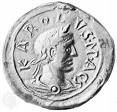
In spring 911 Norse Viking chief Rollo (Hrolf) (Rolf) Ragnvaldsson (the Ganger) (the Walker) (Wend-a-Foot) (845-930) (who once explored the E coast of North Am. as far S as Conn.?) sails down the Seine River with a raiding and settling party, and sieges Chartres, then prepares to ransack gay Paris, until whimpy king of the West Franks (Charles III, you are no Charlemagne?) Charles III the Simple (879-929) (probably hearing that the Vikings can be bought off, like Eli Wallach in the film "The Magnificent Seven", and saying something like, "Rollo, please do not sack gay Paree, just take this box of treasure, and I'll make you a duke and give you my beautiful daughter, the hottest French poontang in the land, and you can move into the bad side of France and have the left bank of the Seine, plus a little of the right bank, where you can have some Lebensraum and act as bouncers for any other Vikings, how about it, guy"?) cops out, and in the fall signs the Piece, er, Treaty of Saint-Clair-sur-Epte (Fr. "sint clair" = "clear well or pool"), granting them land on the left bank of the Seine River (the bad side of France?), with Rouen (on the right bank) (named after him, which is convenient, because it was originally the Gallic city of Ratumacos) as their new capital, on the condition that they defend the land, receive Christian baptism, and do homage to Charles as their overlord; Charles also sweetens the pot by giving Rollo his daughter (sister?) (all made up?) Gisela of France in marriage to cement the deal; when Rollo's proxy goes to perform the rite of allegiance by kissing the king's foot, the rude Viking stands erect, lifts the royal foot to his mouth and topples Charles over backward, causing Rollo's men to have a good laugh?; Rollo founds the French duchy of Normandy (Northmen Duchy - get it?), becoming duke #1 (until 927), and is baptized under the name Robert, becoming Duke Robert I; the Norsemen acquire the French language and culture (which they proceed to inject with Norse words and turn into their own dialect), learn to ride horses, build forts and siege machinery, and continue their raids on Brittany; Charles III's act is so unpopular with his barons that they start calling him Charles the Simple, and later depose and imprison him for it; Charles acquires Lorraine from France.
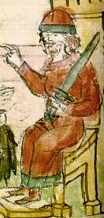
In 912 Prince Oleg dies, and his son Prince Igor I (-945) becomes Varangian ruler of Kiev (until 945); he and his mentor Grand Prince Oleg sail with a large army towards Constantinople, raiding the villages along the Bosporus and obtaining a treaty giving Russian merchants privileges along with shiploads of bribes for their "druzhina" (friends).
In 914 large Viking fleets return to Ireland and refound Waterford (ON "Vedrafjoror" = windy fjord) in the SE (Munster) (modern-day pop. 50K), becoming the oldest Irish city with a Norse name - because it almost sounds English?
In 915 the Vikings occupy and expand the 6th cent. monastic settlement (founded by St. Finbarr) of Cork (Gael. "corcach" = marsh) on the Lee River in Munster, SW Ireland (modern-day pop. 125K/208K), turning it into a trading port, with its harbor becoming one of the largest natural harbors on Earth by navigational area; the city is granted a charter by Prince John in 1185.
In 916 another large Viking fleet arrives in Waterford, Ireland.
On Sept. 14, 919 Niall Glundrub and 5-12 other chieftains (the cream of the Ui Neill) fall to the Dublin-based Vikings of the Ui Imair (Ivar Dynasty) under Sitric (Sihtric) Caech (Cáech) (Sigtrygg Gále) (-927) at the Battle of Islandbridge (Ath Cliath) near Islandbridge, County Dublin.
In 928 the Vikings massacre Irish at Dunmore Cave in County Kilkenny, Ireland.
In 941 Kievan Rus ruler Igor leads a huge fleet (10K ships?) from the Black Sea and terrorizes the coastal areas around Constantinople for several mo. until the Byzantines reservice some mothballed ships and equip them with Greek fire.


In Jan. 945 after Romanus I's sons Stephen and Constantine threaten the throne of Constantine VII, the pop. revolts, and they are sent to join their father in exile in Samothrace, after which Constantine VII Porphyrogenitus (905-59) reigns alone as Roman Byzantine emperor #136 (until Nov. 9, 959), negotiating another commercial treaty with Grand Prince Igor of Kiev, who soon dies fighting rebels in Dereva, leaving his wife Princess (St.) Olga of Kiev (890-969) in charge as regent for her boy son Sviatoslav I (until 964), going on to wipe out the rebels to the last man and teaching him to chuck spears at them, and consolidate Kiev's control over cities as distant as Novgorod; the commercial treaty mentions luxury items they want from the Byzantines incl. silk; Constantine VII requires pesky untrustworthy antichrist Jews testifying in Christian courts to take the humiliating Oath More Judaico, which continues in use in Euro courts until the 20th cent.
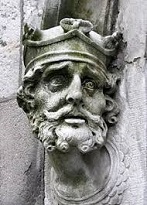
In 968 the Irish of the Dal Cais under Brian Boru defeat the Vikings of Limerick under Ivar of Limerick (-977) at the Battle of Sulcoit in County Tipperary, then burn Limerick the next day, marking the end of Norse expansion in Ireland; in 970 Mathgamain mac Cennetig (Cennétig), elder brother of Brian Boru deposes Munster king (since 959) Mael (Máel) Muad (Molloy) mac Brain (-978), becoming king of Munster until 976, when he is KIA; in 976 C.E. Brian Boru (Boruma) (940-1014) succeeds his brother Mahon as king of the Dalcassians (Dal Cais) based on the River Shannon in Munster, becoming a rival to the Ui Neills and going on to conquer Dublin, Leinster, and all of Ireland; in 978 Molloy is defeated and KIA in the Battle of Belach Lechta (Leachta) by Brian Boru, who becomes king of Munster.
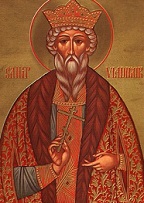
In 980 Vladimir returns from Sweden to Novgorod with a Viking fleet, then marches to Kiev with a large army, inviting his elder brother Yaroslav to negotiate then having him stabbed by two men as he enters the door, and takes over as Grand Duke (St.) Vladimir I Sviatoslavovich the Great (958-1015) of Kiev, working to consolidate the Russian state from the Ukraine to the Baltic, first setting up idols of pagan gods Perun, Khors, Dazhbog, Stribog, Simargl, and Mokosh, then after the news that he's a fratricide gets around, flopping and deciding to convert it to the Orthodox (Constantinople) faith after converting in 988; under him Kievan Rus reaches its height of power, and begins a permanent partnership with the Byzantines.
In 980 after the C Asian silver mines become exhausted, causing their Russian trade routes to collapse, dormant Danish Vikings wake up and again begin to sail their dragon ships to England in hopes of plunder, especially silver, attacking Chester, Southampton, and Thanet; the Vikings from Dublin under Ragnall (Reginald), son of ex-pagan Viking king of Dublin (since 945) Olaf Cuaran (927-81) (known for his love of pillaging churches before converting to Christianity in the 940s) are defeated by the Gaelic Irish of Meath under Malachy II (Mael Sechnaill mac Domnaill) (949-1022) at the Battle of Tara in Ireland, giving the Irish control of the kingdom of Dublin; Ragnall is KIA, and Olaf Curan gets Millennium Fever, abdicating and sailing to Iona in the Hebrides as a penitent, where he dies within a year; Malachy II takes Dublin in a 3-day siege and frees all the slaves, gaining a stronger hand in his rivalry with Munster king Brian Boru.
In 989 halfbreed Norse-Irish (Norse father, Irish mother) Sigtrygg (Sitric) (Sihtric) (Sitrick) (Sigtryg) (Sigtryggr) II Silkbeard Olafsson (970-1042) of Dublin suceeds his paternl half-brother Gluniaim as king of Dublin (until 994), while his rival Ivar of Waterford waits in the wings, and future Norway king Olaf Tryggvason moves in for a few years (until 994) after marrying Sigtrygg's sister Gytha, plundering his foes and weakening them.
On Sept. 8, 994 after returning to England with Svein (Sweyn) Forkbeard of Denmark, Olaf Tryggvason of Norway sieges London, then makes a deal with Ethelred II the Unready, accepting more Danegeld (8 tons of silver) and getting baptized in Andover in return for giving up ransacking England and returning home, then heads for Norway after he hears that King Earl Hakon is doing things to Norwegian women.
In 994 Ivar of Waterford expels Sigtrygg Silkbeard from Dublin, but he returns within a year.
In 995 newly baptized Olaf I Tryggvason (969-1000) conquers Norway, is crowned king (until 1000), then finds that a mob has killed former de factor ruler Earl Haakon Sigurdsson for doing things to women, and declares it a Christian kingdom, becoming its first Christian king and building its first Christian church, going on to convert his subjects using Christian terrorist tactics; the facts that Thor's Hammer amulets have a crucifix shape and the apocalyptic Battle of Ragnarok resembles Armageddon help speed their conversion?; he then sends German (Saxon) bishop Thangbrand to convert the Icelanders, threatening to kill or disfigure several Icelander hostages in Norway to speed them up; Olaf I then sails to Orkney and forces Sigurd Hlodvisson the Stout (960-1014), earl of Orkney N of Scotland to convert to Christianity - onward Christian soldiers?
In 995 King Eric the Victorious of Sweden (who converted to Christianity but apostasized) dies, and is succeeded by his son Olof I Skotkonung (Skötkonung) ("tributary king"?) (980-1022), who is converted in 1008 and doesn't apostasize, becoming the first baptized ruler of Sweden (until 1022); meanwhile his stepfather Sweyn I Forkbeard of Denmark claims his throne.
In 995 Sigtrygg Silkbeard and his nephew Muirchertach Ua Congalaich attack the church in Donaghpatrick in County Meath, pissing-off Mael Sechnaill, who raids Dublin and steals the ring of Thor and the sword of Carlus, pissing-off Sigtrygg, who attacks Kells and Clonard in 997.
In 995 Sigtrygg Silkbeard and his nephew Muirchertach Ua Congalaich attack the church in Donaghpatrick in County Meath, pissing-off Mael Sechnaill, who raids Dublin and steals the ring of Thor and the sword of Carlus, pissing-off Sigtrygg, who attacks Kells and Clonard in 997.
In 997 Norwegian king Olaf Tryggvason sends Thangbrand of Saxony to Iceland along with warrior Gudleif (Gudlaug) Arason on the Bison to convert the pagans to Christianity; too bad, his violent methods make him extremely unpopular, and after he begins murdering poets who lampoon him he flees back to Norway in 999 along with converts Gizur the White and Hjalti Skeggason, who are sent back to Iceland by the king as missionaries, who convert most of the island by 1000, helped by the king holding the sons of four prominent chieftains captive.
In 997 the seaport of Nidaros is founded by King Olav Tryggvason on the S side of the Trondheim Fjord in Norway (250 mi. S of modern-day Oslo) as the capital of Norway (until 1380); it is renamed Trondhjem in 1564, and Trondheim in 1931 (modern-day pop. 190K/274K). The first written reference is made to the port city of Gdansk on the Motlawa branch of the the Gdania River in Poland on the S edge of Gdansky Bay in the Baltic Sea (modern-day pop. 463K/1M).
In 998 Mael Sechnaill (Malachy II) and Munster king Brian Boru force Sigtrygg Silkbeard to recognize their lordship by giving hostages.
Why am I dressed up like a baby, I've no clue? There's no MF way over here? In 999 Dublin king Sigtrygg (Sitric) (Sihtric) (Sitrick) (Sigtryg) (Sigtryggr) II Silkbeard Olafsson (970-1042) (known for minting the first Irish coins) and his maternal uncle Maelmordha (Mael Morda) mac Murchada (-1014), king of the Ui Faelain of N Leinster defeat their cousin, Leinster king #10 (last) (until 1003) Donnchad mac Domnall Claen (Donnchad mac Dómnaill Clóen), and imprison him in Dublin. On Dec. 30, 999 C.E. after revolting against Irish Ard Ri (high king) Brian Boru (Boruma) (940-1014) of Munster and Meath Ard Ri (high king) Malachy II (Mael Sechnaill mac Domnaill) (949-1022), they are defeated at the Battle of Glenn Mama (Glenmama) (Glen of the Gap) in the foothills of the Wicklow Mts. near Lyons Hill between Windmill Hill and Blackchurch in Ardclough, County Kildaire; the V leaves the road to Dublin "free and unimpeded for the victorious legions of Brian and Mael Sechlainn" (Dictionary of English History); Maelmordha escapes by hiding in a yew tree; Brian Boru magnanimously reinstates both of them in their kingdoms, but the humiliation festers for years.
By the end of the 900s the Viking menace began ending as the big voodoo date 1000 scared them into finally converting to Christianity, after which the promised Armageddon and return of Christ failed to materialize, but tough titties, it was too late to go back, since once a child is brought up Christian the Church has their mind for life by age 5, right? (Ditto any religion, unfortunately.)
In 1001 Brian Boru leads his army from Kincora to Athlone on the Shannon River S of Lough Ree in C Ireland to attend a gathering.
In 1002 Irish high king Brian Boru defeats the Norse, and Mael Sechnaill recognizes him as high king of Ireland.

Pass the shillelaghs? On Apr. 23, 1014 (Good Friday) 73-y.-o. Irish (Dal Cais) high king Brian Boru (b. 940) (pr. BRAN boh-ROO) of Munster with an army of 20K from Munster, the Midlands, and S Connacht defeats the Norse and Leinster Irish at the Battle of Clontarf Plain near Dublin, breaking Norse power in Ireland forever, although they still dominate some cities; Boru has a shield wall formed around him because he won't use a weapon on Good Friday, letting his son Murchad, grandson Toirdelbach (b. 999) and cousin Conaing take command, and later begins praying in a tent in Tomar's Wood; after the Banshee of Dalcais Aibell (guardian spirit of the Dalcassians or O'Brien clan) warns him and he ignores it, Brian is murdered in his tent behind the lines after his big V when his men go off pursuing fugitives by loose Dane Brodir of Man, despite Brian's young son Tadg trying to protect him, cutting off the boy's arm and the king's head; Brodir and his companions are captured and executed by being tied to a tree with their own intestines; Jarl Sigurd, Dubhgall and Maelmordha are KIA, and no Viking of rank is left alive; Brian's younger brother Malachy McDonnell (Mael Sechnaill mac Domnaill) (949-1022) becomes Irish high king (until Sept. 2, 1022); Brian's grandson Toirdelbach drowns, his nephew Conaing is KIA, and his son Murchad dies the next morning of a wound; total losses are 6.7K Vikings, 1.1K Leinstermen, and 4K of Brian's men; Sigtrygg continues to rule Dublin until 1034; no foreign Scandinavian army fights on Irish soil for the next cent. and a half; Ireland falls into anarchy as the O'Brians of Munster (S Ireland)), the O'Neils of Ulster (N Ireland), and the O'Connors of Connacht (Connaught) (W Ireland) begin a struggle for supremacy - slainte?
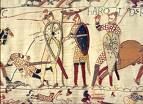




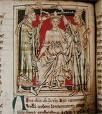

1066: Pop. of Anglo-Saxon England: 1M. The 270' x 20" Bayeux Tapestry (embroidered wool cloth on a linen canvas), created by the victorious Normans starting next year tells the tale of the Norman Conquest of England in the Big Year 1066, incl. the Comet, the Big Bad Conqueror, and Harold with an Arrow in His Eye with Diamonds, complete with a cast of 600 people, 200 horses, 40 ships, and a cameo by Edward the Confessor; only 15 people are named, and only six named in standalone fashion, incl. Harold (twice), William, Robert, Eustace, and the mysterious Turold the Dwarf - the original Sgt. Pepper? I wish I was a little bit taller, like six foot nine? On Jan. 5 Edward the Confessor (b. 1003) (son of Ethelred II and Emma) dies childless in London, and his remains are entombed behind the High Altar of Westminster Abbey, starting a tradition that carries through to George II as every English monarch except Edward V and Edward VII is crowned there; he leaves no Saxon heir to the English throne, but allegedly names his 6'4" blonde brother-in-law Harold Godwinson, earl of Wessex (grandson of prior king Hardicanute Godwin, son of Canute and Emma) as his successor on his deathbed, and on Jan. 5 the Witan elects Harold, who is crowned Harold II Godwinson (1022-66), the 20th monarch of England (last Anglo-Saxon) at Westminster Abbey on Jan. 6, after which on Mar. 20 Halley's Comet appears, which his fellow Anglo-Saxons take as a bad 666 omen (6-6-66); "And in this year also earl Harold was hallowed king; and he experienced little quiet therein, the while that he ruled the realm" (Anglo-Saxon Chronicle); his rival, Norman duke #6 William II (the Bastard) (1026-87) (1st cousin, once removed of Edward the Confessor via his mother Emma, whom he is the grandnephew of) claims the throne by right of succession, and also claims that both Edward and Harold had promised it to him, and gets Harold excommunicated by Pope Alexander II for his dirty business over the exiled Norman archbishop of Canterbury and for not deposing the Anglo-Saxon one, helping William's army by giving him a consecrated banner as a sign of papal approval in hopes of turning the English people gainst Harold, while assembling a fleet of 700 ships in Dives-sur-Mer on the coast of Normandy and assembling an army on the Isle of Wight, causing Harold to begin guarding the coasts of England against William during the summer; too bad, on Sept. 8 after provisions run low, a large part of Harold's force disbands in order to bring in the harvest, and he returns to London; meanwhile Harold's pissed-off brother Tostig Godwinson, earl of Northumbria sails to Norway and persuades Viking king (since 1046) Harald III Hardrada (Haardraade) (1016-66) (did his wife call him that or was he just bragging?) to help him seize the crown, and after waiting for a storm to pass on Sept. 12, they arrive together with a fleet of 270 ships, plunder the coast and burn Scarborough, then sail up the Humber River, attacking from the N at York and defeating the N earls on Sept. 20 at the Battle of Fulford Gate outside Jorvik (York); after receiving the bad news, Harold II issues the immortal gay-curious soundbyte: "I will give him just six feet of English soil, or, since they say he is a tall man, I will give him seven feet"; on Sept. 20 Harold leaves London, gathers the remainder of his c oastal militia along with his thegns and household troops (leaving the S coast unwatched, which gives Duke William his chance), and makes a brilliant dash N, covering 190 mi. in five days, surprising the invaders on Sept. 25 at the Battle of Stamford Bridge 8 mi. E of Jorvik in modern-day East Riding of Yorkshire, becoming the greatest battle so far between Norse and Anglo-Saxons; the over-confident Vikings decide not to wear their armor of leather jerkins with sewn-on metal rings because of the heat, and Harald is KIA with an arrow through his throat; Tostig and many other Vikings are also KIA, and only 30 Viking ships make it back to Norway; England has now been made safe for Anglo-Saxons forever, and they can keep speaking German and there will never be a Shakespeare, right?; too bad, Duke William, promising spoils, has been busy gathering an army of 6K-12K (7.5K?) from Normandy and all over Europe, incl. France, Italy, and Spain (incl. 1K mainly landless Norman knights, plus 500 more from Flanders and Brittany), and sails from Bayeux in Normandy in his long ships (his ship is the Mora, bought for him by his wife Matilda), landing on Sept. 28 in Pevensey (pee in the sea?) on the SW tip of Sussex (65 mi. SSE from London), proceeding to terrorize the countryside, making use of the Chevauchee to burn and pillage in order to force Harold to fight while marching E to Hastings, causing tired Harold and his brothers Gyrth Godwinson (1032-66) and Leofwine Godwinson (1035-66) to hastily attempt to gather a larger force than William (the N earls are too late, and forces end up about equal, incl. 2K-3K Saxon housecarls, and hardly any cavalry like the Normans have, because the insulated Anglo-Saxons never learned to fight on horseback), then march 58 mi. in three days, waiting for William the Bastard a few mi. from Hastings on Caldbec Hill, which with Senlac Hill (Ridge) (originally Santlache, OE for sandy stream, then renamed by the Normans to Sanguelac, Fr. for bloody lake) guards the interior; on Oct. 14 (Oct. 21 Gregorian) (Sun.) after William learns of their position, the 8-hour unhasty Battle of Hastings (Senlac) (one of the longest medieval battles) features the Companions of William the Conqueror fighting an Anglo-Saxon shield wall with feigned Norman retreats to cut them down with cavalry as they try to climb back up the hill; both sides wear chain mail at least, but the Normans have archers and knights, and the Anglo-Saxons take 4K casualties to 2.5K for the Normans, contracting them around tall, blonde, good-arm John Elway, er, Harold, until William's cavalry drives home a charge at Harold, who stands his ground surrounded by his housecarls, but is KIA by an arrow through the eye (according to the Bayeux Tapestry) in the next Norman charge, then his brothers are KIA, and his depleted army flees after losing 25% of their men, later regrouping then suffering more deaths from dysentery; the battle is so close that if Harold could have held out for another hour, an approaching Saxon fleet could have blocked off William's rear and sandwiched him in a 2-front battle, preventing reinforcements or retreat, and the Normans would have been completely crushed?; the battle wipes out the Anglo-Saxon aristrocracy, with the few survivors turned into serfs, allowing the Norman aristocracy to easily take over, and another coup replaces the Anglo-Saxon higher clergy with Normans; the first major medieval battle using knights, spawning their myth of invincibility?; William the Conqueror (Dark Horse MVP of the English Super Bowl, known for his 4th-quarter comebacks?) then plunders SW England, and advances though the Dover Strait towns (Dover, et al.) to secure his communications with Normandy, then up the Thames River looking to cross over to head to London and being repulsed until Anglo-Saxon lord Wigod (Wigot) (kindsman of Edward the Confessor) invites him to cross from W to E at Wallingford in Berkshire N of London, then E to Berkhamsted (Berkhamstead) in order to cut off any aid which Edwin and Morcar might send; meanwhile on Oct. 15 the Witan elects Edgar (the) Aetheling (1051-1126), grandson of Edmund II Ironside (last surviving rep. of the West Saxon royal house of Cerdic) as the new king, never coronating him; too bad, after exchanging letters and failing to recruit enough patriotic Anglo-Saxons from the hinterland, the undefended city of London finally capitulates, sending a delegation outside the walls to kiss foot, and William's army peacock-struts into London, where the Witan offers him the crown, and Edgar resigns on Oct. 10 at Berkhamsted (we were just kidding, you da king, you da king?), being taken back to Normandy by William and treated well until he joins the 1068 rebellion; on Dec. 25 (Christmas Day) William the Bastard becomes William the Conqueror, and is crowned William I (1026-87) (21st English monarch) at Westminster Abbey by York archbishop (since 1060) Ealdred (Aldred) (-1069), assisted by excommunicated Canterbury archbishop Stigand (who has the wealthiest estates in England after Harold), tying England to Normandy for 150 years (until 1204); the first of 3x that England has three kings in the same year (1483, 1936); William begins feudalizing England, completing it by his death in 1087; he keeps the local shires and Hundred Courts, along with the Royal Writ and cool Anglo-Saxon coronation order, but makes sure that estates are spread out over two or more counties to stop attempts at provincial autonomy; each royal tenant-in-chief has to supply from 5-60 knights (in multiples of five) to the king when ordered, a total of 5K for the country; knowing that they can only be made to serve 40 days a year, and are too expensive to transport across the Channel, William institutes scutage ("shield money"), allowing the payment of money in lieu of service so he can hire foreign mercenaries in their place, which later helps the English monarchy raise bigger armies than the French et al.; the Witan is combined with the Norman Curia Ducis (duke's court) to form the Curia Regis (king's court); 3x a year all royal vassals must attend it to hear his announcements, advise him on policy, and hear lawsuits involving the tenants-in-chief; no castles can be built without royal permission; the Anglo-Saxon title of sheriff (shire reeve) is coopted for Norman viscounts, who turn the office from weak to powerful, presiding over the shire courts, where William restores the old Carolingian (and forgotten Anglo-Saxon practice) of swearing-in juries, and acting as local agents of the royal treasury, taking on even the greatest lords in the name of the king; the hereditary rank of baron/baroness (lowest rank, below earl/countess) is created; the title of earl (deriving from the Scandinavian word jarl for chieftain) being cooler to Anglo-Saxons than the Continental title of count, the palatine earldoms of Kent, Hereford, Shrewsbury, and Chester are created, along with the barons of the Cinque Ports (Dover, Hastings, Sandwich, Romney, Hythe, later Winchelsea and Rye) to guard the coast of the Strait of Dover; the fast crushing Norman takeover leads to a loss of prestige for the Anglo-Saxons, who become "dogs", and for the next four decades the haughty superior Normans hold all Anglo-Saxon culture in utter contempt, destroying art works and mss., and turning the Anglo-Saxon language into hut talk fit only for peasants, while for the next 1.5 cents. England becomes a cultural province of France as English society begins to split into a French-speaking upper class and hut-talk-speaking middle and lower classes; the Normans introduce many French words to the Anglo-Saxon dogs, incl. boeuf, mouton, veau, porc, and poularde, which are transformed into beef, mutton, veal, pork, and poultry, along with Latin words, making the dogs want to use them to make themselves seem higher in class, e.g., turning hearty welcome into cordial reception; the Norman takeover was a blessing in disguise since otherwise their disintegrating kingdom would have been taken over by the Norse, cutting off England from exciting French cultural progress, although, duh, the retro Norse wouldn't have destroyed Anglo-Saxon culture and would have eventually been thrown out?; William I becomes Europe's most powerful monarch, setting up a new kind of kingdom that relies on law and admin. machinery rather than ideology to unify it like the Euro monarchies do, beginning the trend toward secularism and absolutism that dominates the 12th and 13th cents.; Norman Romanesque Architecture is born; Fotheringay Castle in Northamptonshire is begun; William I's half-brother Robert of Montain becomes earl of Cornwall, and builds Launceston Castle; the office of queen's (royal) champion is granted to Robert Marmyon, along with the castle-manor of Tamworth and the manor of Scrivelsby, with the job of riding in full armor into Westminster Hall during a coronation to fight anybody challenging the king's title (until 1377); the Norman Pierpoint family settles in a manor in West Sussex (Wessex) taken from Earl Godwin, which becomes known as Hurstpierpoint ("the wood of Pierpoint"); (a new hope?) although William I is king, Harold's partisans still hold most of the wild wild west (Wessex), incl. Barnstaple Castle in Barnstaple, North Devon at the mouth of the Taw River at the entrance to the Bristol Channel, which is granted by William I to Geoffrey de Montbray (-1093), who loses his barony in 1095 after rebelling against William II - Anglo-Saxon Jedi freedom fighters plan revenge against the haughty Norman evil emperor and his stormtroopers, but too bad, their Luke Skywalker is a wuss?
In 1068 after two of Harold Godwinson's sons flee to Ireland after his 1066 death in Hastings and negotiate with Diarmait mac Mael for his Dublin fleet of 52 ships, they sail up the Avon River and attack Bristol, England, but are repulsed, after which they successfully land in Somerset and take plunder, then organize a larger expedition and attack Devon next year, but are repulsed, after which they sail for the court of their uncle the king of Denmark, becoming the last raid by Norse Dublin on England; in 1068 Diarmait mac Mael presents another Irish king with Harold's battle standard.
In July 1069 Leinster-Dublin king Murchad mac Diarmata (b. ?) invades Meath, burning churches and farms until he is badly wounded by defender Feichin, dying next year.
In 1106 Irish scribe Mael Juire mac Cellechair (Máel Muire mac Céilechair) is murdered by Vikings in Clonmacnoise, leaving The Book of the Dun Cow (Lebor na hUidre), which is written on a parchment allegedly from the hide of a dun cow owned by St. Ciaran of Clonmacnoise.
The last Norse invasion of Scotland? On July 11, 1263 the 120-ship Norwegian leidang (lething) fleet sails W to attack Scotland over control of the Hebrides, and enters the Firth of Clyde in Sept. after doing a little plundering along the way; part of the fleet is then sent to Loch Lomond to plunder Lennox and Menteith, while the main body anchors off Little Cumbrae Island and Largs; too bad, on Sept. 30 a storm wrecks four Norwegian ships, and when Haakon IV himself lands with a small force to salvage the wrecks on Oct. 2, Alexander III's testy Scots arrive, led by Alexander Stewart of Bute and Cowal, 4th High Steward of Scotland (1214-83) fight the Battle of Largs around the mouth of the Gogo Water, forcing the Norsemen back into their ships with small losses, retreating to Orkney on Oct. 29, where they over-winter, after which a delegation of Irish kings invites Haakon to help them rid Ireland of the stankin' English settlers as their new high king, which he declines; on Dec. 16 Haakon IV (b. 1204) dies at the bishop's palace in Kirkwall, and his son Magnus VI (the Law-Mender) (Lagabote) (1238-80) becomes king of Norway (until May 9, 1280), while the Scots push their advantage to force him to give up the Hebrides, and within three years all Viking lands are returned to Alexander, although many Viking families continue to live there, mixing with Scottish clan families moving in.
In 1355 King Magnus of Norway-Sweden orders Norwegian sea capt. Paul Knutson to journey to Greenland to restore the Christian faith among the Norsemen still living there.
In 1356 Paul Knutson leads an expedition from Greenland to Vinland (Newport, R.I.), constructing a tower that survives to modern times, and erecting the Kensington Runestone, with Norse runes carved on its surface, in central Minn.?; Knutson and most of his men die in the New World, and the only survivors return to Norway in 1364?; Norse expansion into the New World ends as a result of drought?
In 1360 the E part of the failing Norse colony of Greenland is destroyed by the "Skraelingen" (Skraelings), nomadic hunters from the Far North (Eskimos); they eventually destroy the last group of Greenlanders in the W, burning them down in their church in Harjolfsnes; later a bunch of medieval clothing is found in tombs there, none dating past this cent.
On July 1, 2007 the 100-ft.-long Sea Stallion (Havhingsten) of Glendalough, a Viking replica long ship leaves Roskilde, Denmark on a 1.2K-mi. voyage to Dublin, Ireland, becoming the biggest Viking ship clone, modeled after a real one excavated in 1962 from the Riskilde fjord and dated to 910 C.E.; it arrives on Aug. 15.